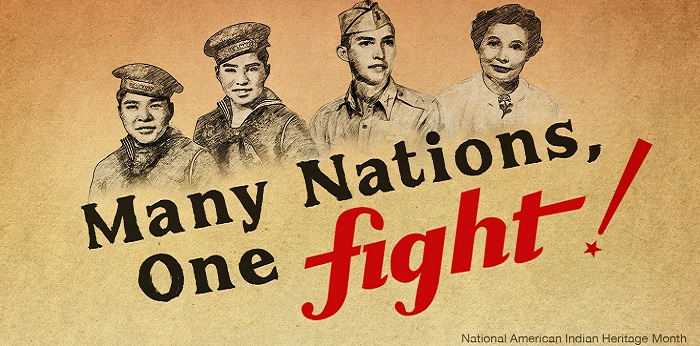The Minnesota Department of Veterans Affairs (MDVA) proudly observes November as Native American Heritage Month as proclaimed by Gov. Tim Walz in recognition that Minnesota is located on ancestral and contemporary lands that have been called home by Indigenous Peoples since time immemorial.
There is a deep, rich Native American history in the State of Minnesota going back 10,000 years. Minnesota is home to eleven Tribal Nations and a resilient and robust urban Native American community. Along with the Dakota people and Anishinaabe people, the Ho-Chunk, Cheyenne, Oto, Iowa, Hidatsa, Arikara, A’aninin, Cree, Blackfeet, Assiniboine, and the Sac and Fox tribes also acknowledge Minnesota as important to their tribal histories.
During Native American Heritage Month, MDVA joins the State of Minnesota in honoring our vibrant and diverse Native American cultures and renewing the state’s commitment to our government-to-government relationships and promote appreciation, tolerance, reconciliation, understanding, friendship, and continued partnerships among all Minnesotans and the Native Peoples of this land.
In Minnesota, our Native American Veterans comprise 0.94% percent of our Veteran population. Among the 574 federally recognized tribes in the United States, military service by Native Americans and Alaska Natives is five times the national average according to The Department of Veterans Affairs Center for Minority Veterans. Although they serve in large numbers, Native American Veterans apply for and receive fewer Veterans benefits than other ethnic groups. MDVA is here to support all Veterans and our Field Operations team directly supports all 11 Native American Tribes in Minnesota through /mdva/about/tribalvso.jspTribal Veteran Service Officers.
Opportunities to celebrate Native American Heritage Month
Community and Veteran-related resources
The Diversity, Equity and Inclusion (DEI) Office at the Minnesota Department of Veterans Affairs strives to create and support a workplace where all employees feel they belong. To ask questions, discuss concerns, or give any suggestions for making the workplace more inclusive, please contact the Director of DEI Valerie Klitzke by phone: 651-219-0176 or email: diversity.MDVA@state.mn.us.
 Image provided by the Defense Equal Opportunity Management Institute
Image provided by the Defense Equal Opportunity Management Institute
Biographies – From left to right
- (1st and 2nd from left): Seaman Mark Jacobs Jr. and Harvey Jacobs, brothers and Alaskan Tlingit members from Sitka, who served in the U.S. Navy as code talkers. In 2019, five long-deceased Alaska Native servicemen were hailed by the state of Alaska for their life-saving efforts during World War II. Until recent years, however, the men’s contributions were unknown. “Their orders were not to talk about it,” said Ozzie Sheakley, an Army veteran and Tlingit leader. “They took those orders seriously.” Alaska lawmakers passed a formal citation honoring the Tlingit men for using their Native language to help the military outsmart the Japanese with codes they could not break.
- (3rd from left): Army Lieutenant Van T. Barfoot, a Choctaw Indian and recipient of the United States military's highest decoration—the Medal of Honor—for his actions in World War II. In May 1944, then Technical Sergeant Barfoot, at the age of 25, set out alone to flank German machine gun positions and stop enemy bullets that were killing his fellow soldiers. He advanced through a minefield and took out three enemy machine gun emplacements with hand grenades. As German tank crew members dismounted from their disabled tank, Sergeant Barfoot killed three of the German soldiers outright with his tommy gun. He then continued further into enemy terrain and destroyed a recently abandoned German fieldpiece with a demolition charge placed in the breech. Returning to his platoon he assisted two of his seriously wounded men 1,700 yards to a position of safety. Barfoot is credited with capturing and bringing back 17 German prisoners of war to his platoon position that day. Barfoot was subsequently commissioned a U.S. Army second lieutenant in the infantry.
- (Right): Mary G. Ross, a civilian mathematician and engineer working on the home front. In 1942, Lockheed Aircraft Company in California hired Ross as a mathematician. With two degrees in mathematics, she was among the many women hired to fill a role, traditionally held by men, while the men were away serving in the military during World War II. The company sent her to the University of California Los Angeles to get her professional certification in engineering – she became the first Native American woman and female engineer in Lockheed’s history. Ross became was one of the 40 founding engineers of the renowned and highly secretive Skunk Works project. Ross worked on designing fighters, to include the famed P-38 Lightning fighter, large planes, first evolution jets, and later rockets. Unlike many other women, who were forced out of their jobs as men returned from the war, Ross continued working for Lockheed until her retirement in 1973. In 2018, Ross was chosen to be depicted on the 2019 Native American $1 coin by the U.S. Mint celebrating American Indians in the space program.
 Image provided by the Defense Equal Opportunity Management Institute
Image provided by the Defense Equal Opportunity Management Institute